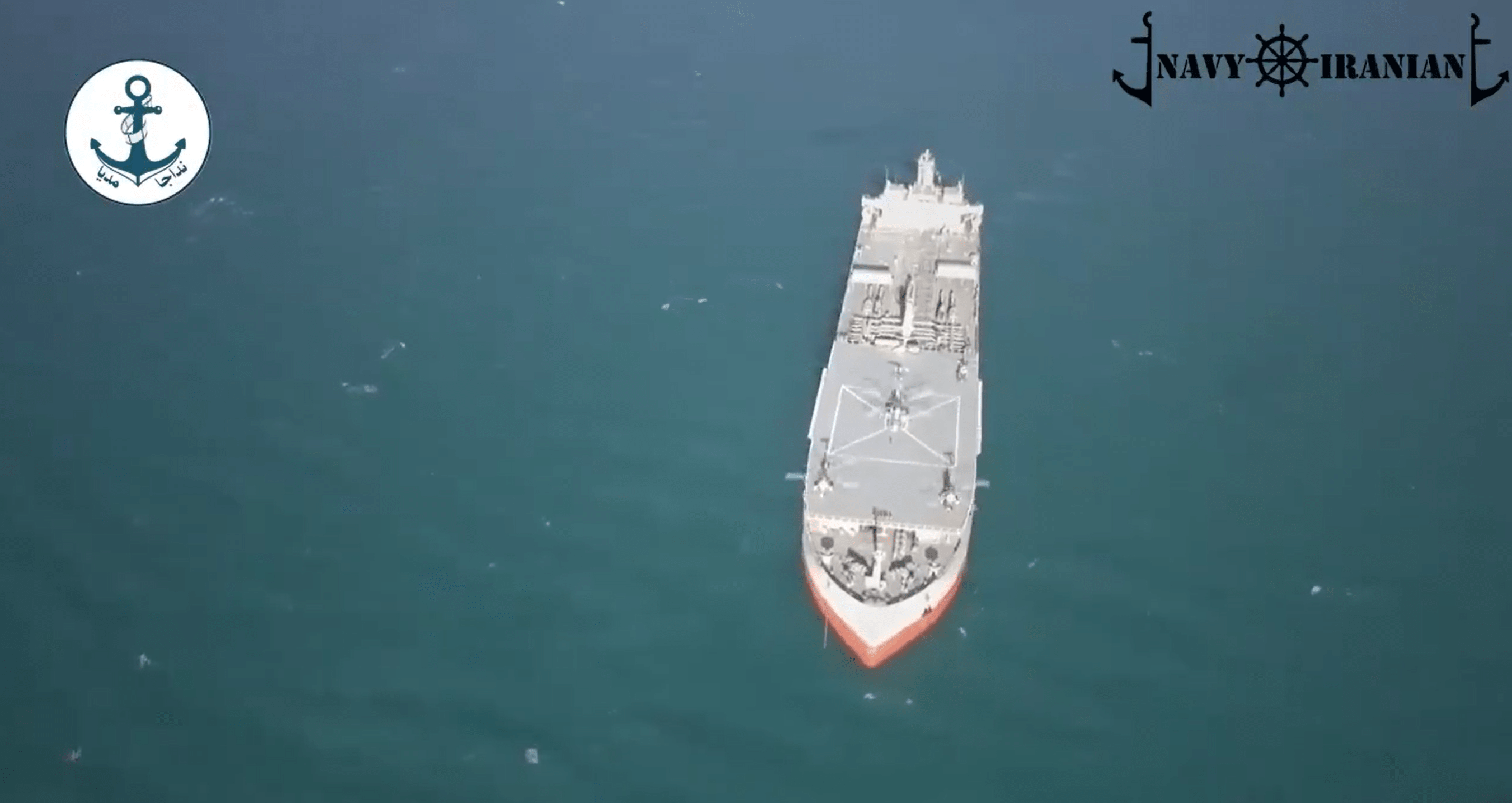Mane obviligo
If the passage of Russian nuclear submarines caused a furore, the entry of the largest ship of the Iranian navy into the Baltic Sea accompanied by an Iranian frigate is no less so. For weeks, ship spotters had been following the course of two Iranian naval units with different interpretations of their destination. On the morning of 22 July, the supply ship "Makran" passed the bridge over the Great Belt. Her escort ship, the frigate "Sahand", was already several nautical miles ahead of her. The two units will represent Iran at the parade to mark the 325th anniversary of the Russian Navy. Also on 22 July, the Iranian news agency IRNA announced a statement to this effect by the commander of the Iranian Navy, Rear Admiral Hossein Khanzadi. He himself will be travelling to St. Petersburg. Tasnim News reports the arrival of the Iranian naval vessels in St. Petersburg on the afternoon of 24 July 2021.
The converted oil tanker IRINS "Makran" is the largest warship in the Iranian Navy. IRINS stands for Islamic Republic of Iran Navy Ship. In Iranian terminology, it is referred to as a 'forward base ship'. In addition to general logistical support, its tasks - according to official statements - include carrying out search and rescue missions (SAR missions), supporting the deployment of special forces, providing support for speedboats, replenishing fuel and other supplies, caring for the wounded and "transporting and operating radar and missile systems". The latter is the description for its equipment with long-range missile systems. For example, the cruise missile 'Shahid' (Martyr) (or Shahid Abu-Mahdi al-Muhandis in the long form) with a range of 1,000 kilometres. The Ghadir ship-to-ship missile (the navalised form of the Ghader land-to-ship missile used by trucks), which has also been fitted with scaffolding, has a range of 330 kilometres. The "Makran" is said to be capable of carrying six speedboats and/or four mini-submarines (so-called Midget). However, the task of 'supporting speedboats' is not necessarily the same as what is understood in this country by a speedboat tender. The speedboats are equipped with 107 mm rocket launchers. The small submarines are designed to carry special forces, with the capacity to transport 150 troops. It should be noted here that Iran's armed forces include special forces both in the regular branches of the armed forces (army, air force, navy) and in the respective organisations (for land, air or maritime operations) of the Iranian Revolutionary Guards IRGC). The "Shahid Roudaki", which was commissioned in November 2020, serves as a support ship ('forward base ship') for the Revolutionary Guards and is smaller than the "Makran".
"Makran" offers options for several types of helicopter: two AB 212, two ASH-3D 'Sea King' (sub-hunting and SAR) and one RH-53D 'Sea Stallion' will be able to be deployed from it. In addition, "Makran" is capable of deploying unmanned drones. It is said to carry an unmanned aerial vehicle with a range of 1,200 kilometres. In a propaganda video, the launch of a drone, presumably a 'Pelican' VTOL UAV, is shown from the deck of the "Makran", without going into further detail about its operational capabilities and integration into the ship's command and control system. The ship is said to have a fully equipped ship's hospital with infirmary. "Makran" was commissioned in January 2021.
Dimensions IRINS "Makran" (Hull number 441)
| Length (m) | 230 |
| Width (m) | 42 |
| Draught (m) | 21,5 |
| Displacement (t) | 111 530 |
| Speed (knots) | 14,5 |
The "Sahand" frigate belongs to the Mowj class, of which four ships have been commissioned since 2010 and three more are currently under construction. The Iranian self-built ship is considered to be Iran's most modern warship class. Construction number 2 (with the hull number 77) was a total loss due to an accident. Like its two sister ships, "Sahand" (hull number 74) has a 76 mm turret (Fajr), two launchers of the Mehrab ship-to-air missile system, four Ghadir ship-to-ship missiles and two three-tube torpedo launchers. A six-barrelled short-range anti-aircraft gun (Kamand), 23mm guns (not fully confirmed) and two chaff launchers are also on board. According to Jane's, all four Mowj ships have different radar systems. All are said to have a phased array radar. For air support, these frigates have the Bell 214 helicopter in the sub-hunting role.
Dimensions frigates Mowj class
IRINS "Sahand" (Hull number 74)
| Length (m) | 95 |
| Width (m) | 11,1 |
| Draught (m) | 3,25 |
| Displacement (t) | 1 500 |
| Speed (knots) | 30 |
| Crew | 140 |
Initial confusion about the intentions of the Iranian association
After the ships left Bandar Abbas on 10 May 2021, US authorities in particular assumed that the ships were on their way to Venezuela as an expression of the deepening relations between Tehran and Caracas. It was initially assumed that Tehran intended to deliver the boats on the upper deck to the (from an American perspective) undesirable Maduro regime. Speculation was fuelled by the route around the Cape of Good Hope and a lengthy stopover off the coast of Senegal. An onward journey to the Mediterranean with destination Syria was considered by experts. In the end, "Makran" and "Sahand" travelled via the Bay of Biscay, the English Channel and around Skagen into the Baltic Sea. The intention behind the chosen route around the northern tip of Denmark may have been to avoid giving away too much information. This risk would have existed when passing through the Kiel Canal.
"Makran" could make many things possible - mane obviligo
When categorising the voyage of the two Iranian warships, many observers insist that Iran has finally succeeded in providing proof of 'blue water operations'. The ambition is not new. Back in September 2011, the then naval commander, Rear Admiral Habibollah Sayyari, announced his intention to station naval vessels in the Atlantic Ocean close to the territorial waters of the United States. Only time will tell whether the current 'maiden voyage' of the Iranian navy is indeed an indicator of future and sustained wider operations by Iran's naval forces. Certainly, for the navy and the government in Tehran, it is an expression of its maritime capabilities and proof of its efficiency - despite all Western aversions and restrictions. "The presence of Iranian ships in the Atlantic is a turning point" headlines Tehran Times on 15 June 2021.
The fact is, however, that the "Makran" could be stationed as a mother ship in the open sea off relevant operational areas. It offers a platform for more permanent maritime operations in and outside Iran's coastal areas. This includes humanitarian operations, maritime security missions and counter-piracy operations as well as asymmetric operations at sea or from sea to land. It should be emphasised here that "Makran" also opens up unconventional possibilities for the use of weapons. It is possible to deploy containerised missile systems from its deck, including truck-based systems. In this respect, it does not necessarily have to be assumed that the weapon systems are scaffolded. Other possibilities for covert warfare include the use of speedboats transported on the upper deck. In April 2021, the case of the MV "Saviz" caused an international sensation when the Iranian ship, which was considered a base for the Revolutionary Guard and had been anchored in the Red Sea under the Yemeni coast for years, was attacked. In addition to its role as a reconnaissance unit, the "Saviz" was considered a mother ship for covert operations.
The message from Tehran behind the presence of the "Makran" in the Baltic Sea may be: Stay vigilant, we are a force to be reckoned with!












Super informative! I once distributed it here in my area as "N2 instruction" 😉
Also a convinced speedboat and S.Boot Tender driver 😉
Very nice contribution!